How DRaaS Helps VARs And MSPs Grow Their Business
By Seth Woodward, Sales Enablement Specialist, TBI
The scare of Hurricane Matthew further proves a scalable and flexible disaster recovery plan should be in place before a natural disaster, hardware failure, or human error puts a company’s viability in jeopardy. To minimize loss and reputation damage, businesses must have systems that protect data and applications so employees can resume normal operations as soon as possible.
Today, too many companies rely on in-house IT infrastructures without a strategy to access data and applications in the event of an outage. Unfortunately, numerous businesses lack the staff and expertise to overcome losses when disaster strikes. This opens the door for MSPs and VARs to start the conversation about DRaaS, the replication and hosting of physical or virtual servers by a third-party provider. When an incident occurs, these servers power up to ensure applications and data can be accessed with limited or no interruption.
Why DRaaS
Because most businesses live and die by their reputations and the data they possess, selling DRaaS positions MSPs and VARs for growth. 451 Research Market Monitor forecasts the DRaaS market will bring in revenues of more than $1 billion next year. Likewise, Gartner predicts the use of DRaaS or IaaS to support the failover of production applications will grow by more than 200 percent from 2016 through 2020.
Among the several benefits that DRaaS presents, business continuity is the most alluring. When setting up a disaster recovery plan, providers help the customer establish a plan for backup and replication, ensuring operations continue during and after a disaster. Other benefits include:
- revenue protection
- downtime and data-loss prevention
- faster application recovery
- flexibility in recovery options
- leveraging of existing backup software (Zerto, Veeam, VMware, etc.)
DRaaS also requires fewer operational resources because it reduces the need for end users to manage backup servers, software licenses, and hardware. Service providers support operations with their own data centers, bandwidth, and computing power. Additionally, select DRaaS providers offer regulatory compliance, encryption, and monitoring.
Identifying Potential Customers
All businesses that must meet regulatory compliance requirements are good targets, but verticals most in need of DRaaS are financial services and healthcare. In fact, Gartner estimates businesses within these two industries are among the earliest adopters of DRaaS, reporting 16 percent of financial service and 11 percent of healthcare companies have already purchased DRaaS.
In general, SMBs lack the resources and expertise needed to devise an effective DR plan. A strategy that encompasses DRaaS can level the playing field for those that can’t quickly get their systems back online. Also, the flexibility of DRaaS makes solutions affordable for SMBs, allowing them to determine and plan for how much backup they need.
While SMBs are optimal targets, don’t overlook enterprise customers. In 2015, Gartner witnessed a 77 percent increase in DRaaS inquiries from enterprises. Because of their size, these businesses typically need a greater backup frequency and faster recovery time. There are multiple DRaaS solutions available to meet the downtime requirements of businesses, ranging from 48 hours to instantaneous.
More Than Just Selling
It’s important to note DRaaS must be part of a comprehensive disaster recovery plan. You also need to consult with executives from a prospective business to ensure they’ve approved a budget for implementation. Demand is always going to be high from IT, but your time and effort will amount to nothing if the C-suite doesn’t want to allocate budget for DRaaS.
After the sale, you must help devise a disaster recovery plan, assist with migration, and, most importantly, test it to ensure it works. A best-of-breed DRaaS provider will offer Test Restore capabilities to ensure data has been backed up and replicated before a disaster occurs.
It’s also recommended that you apply the 3-2-1 rule. This best practice for preventing data loss requires the following:

Seth Woodward is the Sales Enablement Specialist for TBI, the nation’s leading distributor of technology services — also referred to as a Master Agent. Woodward manages TBI’s portfolio of vendors and develops sales and training initiatives that empower the technology channel to expand services sold to its clients. Previous to TBI, Woodward worked at a technology firm bringing next-gen networking and video solutions to market for national retailers. He is an MBA-candidate at the Kellogg School of Management at Northwestern University.
